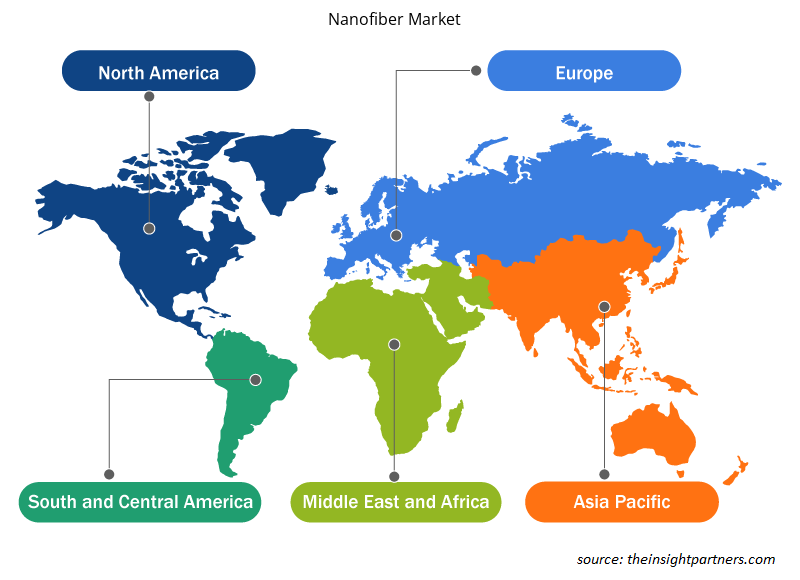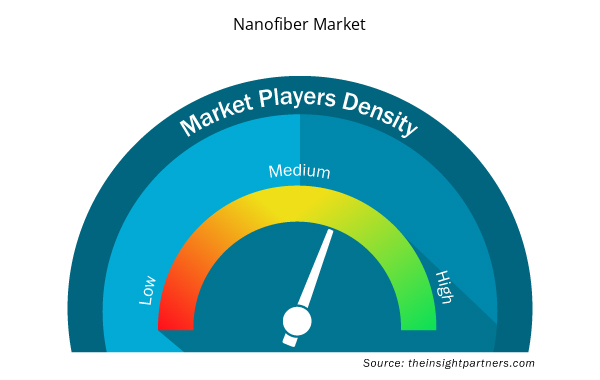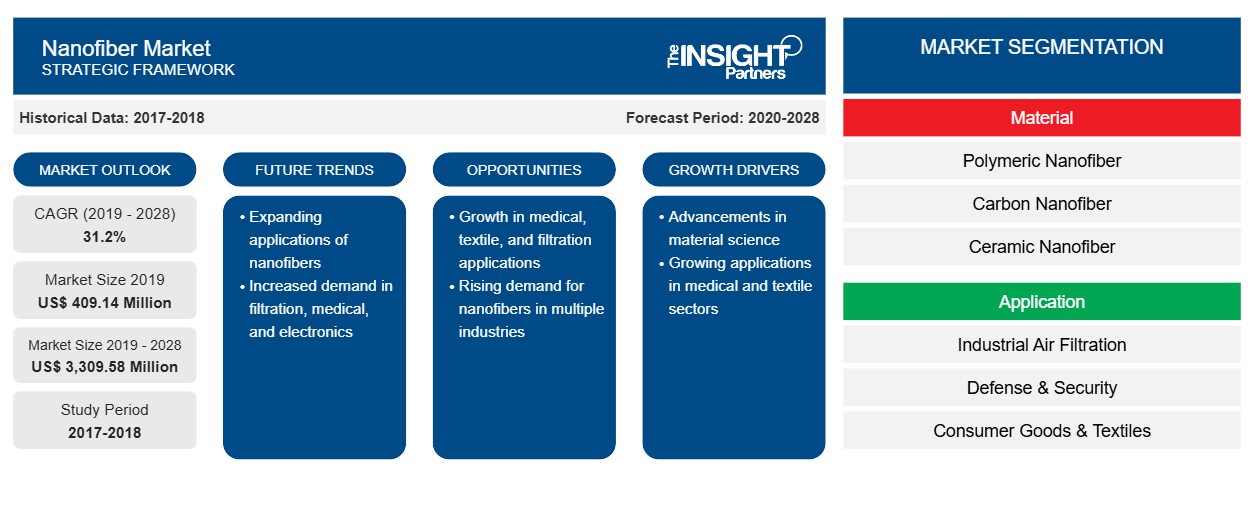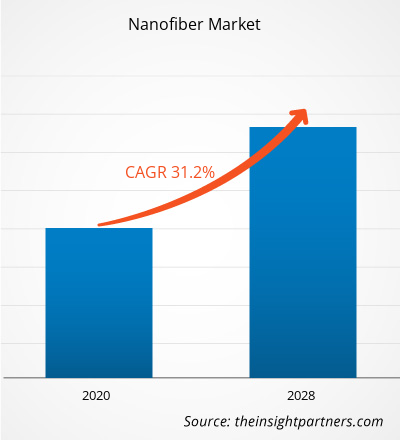ナノファイバー市場は2019年に4億914万米ドルと評価され、2028年までに33億958万米ドルに達すると予測されており、2020年から2028年にかけて31.2%のCAGRで成長すると予想されています。
ナノファイバーは、直径が 1 µm 未満の繊維です。これらの繊維は、透過性が比較的わずかに低下するだけで、ろ過効率を高めるのに役立ちます。急速な工業化、工業用途の増加によるナノファイバー製品の商業化の拡大、技術革新への継続的な取り組み、研究開発投資の増加は、ナノファイバー市場の成長に寄与する重要な要因です。
2019年、ナノファイバーの最大の市場はアジア太平洋地域でした。アジア太平洋地域には、製造業で高い成長を遂げている多くの発展途上国があり、この地域は世界的な製造業の中心地となっています。中国が高度なスキルを要する製造業の中心地へと進化する中、インド、韓国、台湾、ベトナムなどの他の発展途上国は、低~中程度のスキルを要する製造施設を人件費の安い近隣諸国に移転したいと考えている多くの企業を引きつけています。これらの国の政府も、投資アイデアを改善したり、外国直接投資(FDI)を奨励したりすることで、そのような企業を歓迎しています。
COVID-19は、政府によるロックダウン、渡航禁止、事業閉鎖により、さまざまな国の経済や産業に悪影響を及ぼしています。化学・素材産業は、サプライチェーンの断絶、技術イベントのキャンセル、オフィス閉鎖という形で深刻な混乱に見舞われている主要産業の1つです。北米、ヨーロッパ、アジア太平洋、南米、中東、アフリカのさまざまな工場の閉鎖により、世界のサプライチェーンが制限され、製造活動、納期、製品販売に支障が出ています。さらに、さまざまな企業がすでに製品納品の遅延や製品の将来的な販売低迷の可能性を予測しています。ヨーロッパ、アジア、北米の国々が課した渡航禁止は、ビジネスコラボレーションやパートナーシップの機会を妨げています。これらの制限に加えて、社会的距離の確保措置による労働力の不足や生産レベルの低下が、化学・素材産業やそれに関連するさまざまな市場の活動を妨げる要因となっています。多くの国が現在、通常の状態に戻りつつありますが、多くの国が感染拡大の第二波を経験しています。さらに、ワクチン接種の推進により、今後数か月で状況が変化する可能性があります。
要件に合わせてレポートをカスタマイズする
このレポートの一部、国レベルの分析、Excelデータパックなど、あらゆるレポートを無料でカスタマイズできます。また、スタートアップや大学向けのお得なオファーや割引もご利用いただけます。
- このレポートの主要な市場動向を入手してください。この無料サンプルには、市場動向から見積もりや予測に至るまでのデータ分析が含まれます。
市場分析
急速な工業化と工場からの有害物質排出削減の必要性
ますます多くの新しい地域が、地元での製造工場の導入に投資するにつれて、世界の製造業は急速に拡大しています。中国物流購買連合会(CFLP)によると、世界の製造業の購買担当者指数(PMI)は、2017年10月には55.1、2017年9月には55.9でしたが、指数は全体的にこれらの月にピークに達しています。PMI指数は2017年初頭以来約53.5で、先進国の製造業の堅調な回復、新興経済国の産業進歩の増加、および世界市場での商品価格の高騰を示しています。急増する製造業は、工場の生産性を向上させるとともに、顧客の嗜好の変化に関する最新情報を常に把握することにより、技術の進歩を取り入れて競争上の優位性を獲得すると予想されます。製造業は現在、現代の工場の見通しとプロセスを変えている技術ルネッサンスの真っ只中にあります。しかし、さまざまな産業の活動の拡大は、特に重工業化が進んだ都市において、環境汚染の一因にもなっています。重工業化は有毒な排出物を通じて、これらの産業の近くに住む人々の健康にも影響を与えています。
マテリアルインサイト
材料に基づいて、ナノファイバー市場は、ポリマーナノファイバー、カーボンナノファイバー、セラミックナノファイバー、ガラスナノファイバー、その他に分類されます。カーボンナノファイバーセグメントは、2020年に最大のシェアでナノファイバー市場をリードしました。カーボンナノファイバーは、合成ポリマーとバイオポリマーから非常に高温で非炭素元素を除去することによって作られます。カーボンナノファイバー製造の浮遊触媒法では、粉末または支持体の形のさまざまな金属が触媒体として使用されます。箔、ガーゼ、ワイヤーなどは、ナノファイバーの製造に使用される他の触媒です。カーボンナノファイバーは、他の物理的特性の中でも、高い不連続性と適合性を示し、また高度にグラファイト化されています。優れた機械的特性を持ち、電気伝導性と熱伝導性が高くなっています。カーボンナノファイバーの応用分野には、熱可塑性プラスチック、エラストマー、熱硬化性プラスチック、セラミック、エラストマー、金属が含まれます。また、カーボンナノファイバーは、高い引張強度、熱伝導性、電気伝導性を備えているため、整形外科、歯科、組織工学の足場にも広く使用されています。
アプリケーションインサイト
用途に基づいて、ナノファイバー市場は、産業用空気ろ過、防衛およびセキュリティ、消費財および繊維、電子部品、電力およびエネルギー、ヘルスケアおよびライフサイエンス、化学および環境、その他に分類されます。ヘルスケアおよびライフサイエンスセグメントは、2020年に最大のシェアで市場をリードしました。ナノファイバーに使用される生分解性材料は、医療およびヘルスケア業界に最適です。さらに、添加剤の統合により、これらのナノファイバーの多機能性が可能になります。構造とサイズを制御できるため、組織工学に使用できます。ライフサイエンスおよび製薬業界におけるナノファイバーの主な用途には、薬物送達、創傷治癒、組織工学、バリアテキスタイルなどがあります。
ナノファイバー市場の主要企業には、Ahlstrom-Munksjo、旭化成株式会社、Donaldson Company、DuPont、Nanofibers Solution LLC、Toray Industries、Espin Technologies、Elmarco SRO、Mempro Ltd.、Revolution Fibers Ltd.などがあります。市場の主要企業は、地理的プレゼンスと顧客基盤を拡大するために、合併や買収、新製品の発売などの戦略に注力しています。たとえば、2018年にDonaldsonは、ガスタービンフィルターの選択を容易にする革新的なシステムを導入し、オペレーターが交換用エアフィルターを選択しやすくし、パルス回復率と防水性を定量化する実験室テストを開発しました。
レポートの注目点
- 世界のナノファイバー市場における進歩的な業界動向は、プレーヤーが効果的な長期戦略を策定するのに役立ちます。
- 先進国市場と発展途上国市場で事業を展開する企業が採用する事業成長戦略
- 2017年から2027年までの世界のナノファイバー市場の定量分析
- さまざまな業界におけるナノファイバーの需要の推定
- 市場の成長を予測するために業界で活動するバイヤーとサプライヤーの有効性を示すPEST分析
- 競争市場シナリオとナノファイバー需要を理解するための最近の動向
- ナノファイバー市場の成長を牽引・抑制する要因と相まって、市場の動向と見通し
- 世界的なナノファイバー市場の成長に関する商業的関心を支え、意思決定プロセスを促進する啓発的な戦略
- 市場のさまざまなノードにおけるナノファイバー市場規模
- ナノファイバー市場の詳細な概要とセグメンテーション、および業界の動向
- 有望な成長機会があるさまざまな地域のナノファイバー市場規模
ナノファイバー市場の地域別洞察
予測期間を通じてナノファイバー市場に影響を与える地域的な傾向と要因は、Insight Partners のアナリストによって徹底的に説明されています。このセクションでは、北米、ヨーロッパ、アジア太平洋、中東、アフリカ、南米、中米にわたるナノファイバー市場のセグメントと地理についても説明します。

- ナノファイバー市場の地域別データを入手
ナノファイバー市場レポートの範囲
| レポート属性 | 詳細 |
|---|---|
| 2019年の市場規模 | 4億914万米ドル |
| 2028年までの市場規模 | 33億958万米ドル |
| 世界のCAGR(2019年 - 2028年) | 31.2% |
| 履歴データ | 2017-2018 |
| 予測期間 | 2020-2028 |
| 対象セグメント | 素材別
|
| 対象地域と国 | 北米
|
| 市場リーダーと主要企業プロフィール |
|
ナノファイバー市場のプレーヤー密度:ビジネスダイナミクスへの影響を理解する
ナノファイバー市場は、消費者の嗜好の変化、技術の進歩、製品の利点に対する認識の高まりなどの要因により、エンドユーザーの需要が高まり、急速に成長しています。需要が高まるにつれて、企業は提供を拡大し、消費者のニーズを満たすために革新し、新たなトレンドを活用し、市場の成長をさらに促進しています。
市場プレーヤー密度とは、特定の市場または業界内で活動している企業または会社の分布を指します。これは、特定の市場スペースに、その規模または総市場価値と比較して、どれだけの競合相手 (市場プレーヤー) が存在するかを示します。
ナノファイバー市場で事業を展開している主要企業は次のとおりです。
- アールストロム=ムンクショ
- 旭化成株式会社
- ドナルドソンカンパニー
- デュポン
- ナノファイバーソリューションLLC株式会社
免責事項:上記の企業は、特定の順序でランク付けされていません。

- ナノファイバー市場のトップキープレーヤーの概要を入手
ナノファイバー市場(材質別)
- ポリマーナノファイバー
- カーボンナノファイバー
- セラミックナノファイバー
- ガラスナノファイバー
- その他
ナノファイバー市場 – 用途別
- 産業用空気ろ過
- 消費財・繊維
- 電子部品
- 防衛とセキュリティ
- 電力とエネルギー
- ヘルスケアとライフサイエンス
- 化学と環境
- その他
企業プロフィール
- アールストロム・ムンクショー、
- 旭化成株式会社
- ドナルドソンカンパニー株式会社
- デュポン
- ナノファイバーソリューションLLC株式会社
- 東レ株式会社
- エスピンテクノロジー
- エルマルコSRO
- メムプロ株式会社
- レボリューションファイバーズ株式会社
- 過去2年間の分析、基準年、CAGRによる予測(7年間)
- PEST分析とSWOT分析
- 市場規模価値/数量 - 世界、地域、国
- 業界と競争環境
- Excel データセット



Report Coverage
Revenue forecast, Company Analysis, Industry landscape, Growth factors, and Trends

Segment Covered
This text is related
to segments covered.

Regional Scope
North America, Europe, Asia Pacific, Middle East & Africa, South & Central America

Country Scope
This text is related
to country scope.
よくある質問
Polymeric nanofibers are generated from naturally or artificially synthesized polymers. Natural polymers include collagen, silk fibroin, cellulose, gelatin, chitosan and polysaccharides. While synthetic polymers include nylon, polyacrylonitrile, polystyrene, polycarbonate, Polyethylene terephthalate (PET), and water-soluble polymers. These fibers possess high specific area, excellent porosity and better flexibility in surface functionalities. They find enormous applications in various domains such as filtration, material reinforcements, energy storage, sensor devices and others. The growing demand from energy, water, chemicals, pharmaceutical, biotechnology, and food & beverage industries are expected to drive the market for polymer nanofibers across the globe. Apart from this, they are utilized in bone tissue engineering applications in the medical sector which further fueling the demand for polymer nanofiber globally.
The major players operating in the global nanofiber market are Ahlstrom-Munksjo, Asahi Kasei Corporation, Donaldson Company, Inc., DuPont, Nanofibers Solution LLC, Inc., Toray Industries, Inc., Espin Technologies, Elmarco S.R.O., Mempro Ltd., and Revolution Fibers Ltd.
In 2019, Asia Pacific contributed to the largest share in the global nanofiber market. The improving infrastructure, rising domestic consumption and lower costs are some of the factors attracting manufacturing companies in these countries. The development of manufacturing hub creates the demand for nanofibers to be used for a diverse range of purposes. Several governments have taken initiatives such as Made in China 2025, and Make in India, among others to propel the growth of manufacturing sector which further supports the growth of nanofibers market.
Trends and growth analysis reports related to Chemicals and Materials : READ MORE..
The List of Companies - Global Nanofiber Market
- Ahlstrom-Munksjo
- Asahi Kasei Corporation
- Donaldson Company, Inc
- DuPont
- Nanofibers Solution LLC, Inc.
- Toray Industries, Inc
- Espin Technologies
- Elmarco S.R.O.
- Mempro Ltd.
- Revolution Fibers Ltd.
The Insight Partners performs research in 4 major stages: Data Collection & Secondary Research, Primary Research, Data Analysis and Data Triangulation & Final Review.
- Data Collection and Secondary Research:
As a market research and consulting firm operating from a decade, we have published and advised several client across the globe. First step for any study will start with an assessment of currently available data and insights from existing reports. Further, historical and current market information is collected from Investor Presentations, Annual Reports, SEC Filings, etc., and other information related to company’s performance and market positioning are gathered from Paid Databases (Factiva, Hoovers, and Reuters) and various other publications available in public domain.
Several associations trade associates, technical forums, institutes, societies and organization are accessed to gain technical as well as market related insights through their publications such as research papers, blogs and press releases related to the studies are referred to get cues about the market. Further, white papers, journals, magazines, and other news articles published in last 3 years are scrutinized and analyzed to understand the current market trends.
- Primary Research:
The primarily interview analysis comprise of data obtained from industry participants interview and answers to survey questions gathered by in-house primary team.
For primary research, interviews are conducted with industry experts/CEOs/Marketing Managers/VPs/Subject Matter Experts from both demand and supply side to get a 360-degree view of the market. The primary team conducts several interviews based on the complexity of the markets to understand the various market trends and dynamics which makes research more credible and precise.
A typical research interview fulfils the following functions:
- Provides first-hand information on the market size, market trends, growth trends, competitive landscape, and outlook
- Validates and strengthens in-house secondary research findings
- Develops the analysis team’s expertise and market understanding
Primary research involves email interactions and telephone interviews for each market, category, segment, and sub-segment across geographies. The participants who typically take part in such a process include, but are not limited to:
- Industry participants: VPs, business development managers, market intelligence managers and national sales managers
- Outside experts: Valuation experts, research analysts and key opinion leaders specializing in the electronics and semiconductor industry.
Below is the breakup of our primary respondents by company, designation, and region:

Once we receive the confirmation from primary research sources or primary respondents, we finalize the base year market estimation and forecast the data as per the macroeconomic and microeconomic factors assessed during data collection.
- Data Analysis:
Once data is validated through both secondary as well as primary respondents, we finalize the market estimations by hypothesis formulation and factor analysis at regional and country level.
- Macro-Economic Factor Analysis:
We analyse macroeconomic indicators such the gross domestic product (GDP), increase in the demand for goods and services across industries, technological advancement, regional economic growth, governmental policies, the influence of COVID-19, PEST analysis, and other aspects. This analysis aids in setting benchmarks for various nations/regions and approximating market splits. Additionally, the general trend of the aforementioned components aid in determining the market's development possibilities.
- Country Level Data:
Various factors that are especially aligned to the country are taken into account to determine the market size for a certain area and country, including the presence of vendors, such as headquarters and offices, the country's GDP, demand patterns, and industry growth. To comprehend the market dynamics for the nation, a number of growth variables, inhibitors, application areas, and current market trends are researched. The aforementioned elements aid in determining the country's overall market's growth potential.
- Company Profile:
The “Table of Contents” is formulated by listing and analyzing more than 25 - 30 companies operating in the market ecosystem across geographies. However, we profile only 10 companies as a standard practice in our syndicate reports. These 10 companies comprise leading, emerging, and regional players. Nonetheless, our analysis is not restricted to the 10 listed companies, we also analyze other companies present in the market to develop a holistic view and understand the prevailing trends. The “Company Profiles” section in the report covers key facts, business description, products & services, financial information, SWOT analysis, and key developments. The financial information presented is extracted from the annual reports and official documents of the publicly listed companies. Upon collecting the information for the sections of respective companies, we verify them via various primary sources and then compile the data in respective company profiles. The company level information helps us in deriving the base number as well as in forecasting the market size.
- Developing Base Number:
Aggregation of sales statistics (2020-2022) and macro-economic factor, and other secondary and primary research insights are utilized to arrive at base number and related market shares for 2022. The data gaps are identified in this step and relevant market data is analyzed, collected from paid primary interviews or databases. On finalizing the base year market size, forecasts are developed on the basis of macro-economic, industry and market growth factors and company level analysis.
- Data Triangulation and Final Review:
The market findings and base year market size calculations are validated from supply as well as demand side. Demand side validations are based on macro-economic factor analysis and benchmarks for respective regions and countries. In case of supply side validations, revenues of major companies are estimated (in case not available) based on industry benchmark, approximate number of employees, product portfolio, and primary interviews revenues are gathered. Further revenue from target product/service segment is assessed to avoid overshooting of market statistics. In case of heavy deviations between supply and demand side values, all thes steps are repeated to achieve synchronization.
We follow an iterative model, wherein we share our research findings with Subject Matter Experts (SME’s) and Key Opinion Leaders (KOLs) until consensus view of the market is not formulated – this model negates any drastic deviation in the opinions of experts. Only validated and universally acceptable research findings are quoted in our reports.
We have important check points that we use to validate our research findings – which we call – data triangulation, where we validate the information, we generate from secondary sources with primary interviews and then we re-validate with our internal data bases and Subject matter experts. This comprehensive model enables us to deliver high quality, reliable data in shortest possible time.


 このレポートの無料サンプルを入手する
このレポートの無料サンプルを入手する